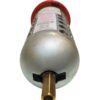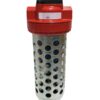RTI Eliminizer Model 3P-060-PP4-FI 1/2″, Max Flow 60 SCFM, Polycarbonate Bowl, Max. PSI 150
The RTI Eliminizer is designed primarily to remove condensed liquids and dirt larger than 1.0 micron and features patented inverse flow technology. The dryer is most efficient when put as close to the application as feasible and uses a stainless steel and cotton element to address the majority of application issues. The Eliminizer can handle flows up to 150 SCFM and is available with polycarbonate, aluminium, or stainless steel bowls with connectors ranging from 1/4″ to 1″, but this specific model 3P-060-PP4-FI comes with 1/2″ connection size.
At the site of use, the Eliminizer’s installation will result in clean, dry air.
Specifications:
Model Number: 3P-060-PP4-FI
Size: 1/2″
Max Flow: 60 SCFM
Bowl Material: Polycarbonate
Max Pressure: 150 PSI
Applications: Generally used at point-of-use and in heavy-duty service where heavy water and dirt removal is needed
This type of application dryer utilises four stages of the drying principle. The manufacturer Reading Technologies, Inc. (RTI) has been at the forefront of advanced air system technology since 1986. Their innovations include compressor room desiccant and refrigerated dryers, mainline separators/ coalescers, point-of-use dryers, and filter/regulator/lubricator units. Below is an explanation of how RTi uses its patented Inverse-Flow® Technology to give you the best clean, dry air for your needs.
- Centrifugal Spin: As the air rushes vertically downward, large amounts of contaminated water, oil, and dirt enter and are spun in a circular motion. The patented element design naturally produces a spinning action that pushes heavier particles outward, where they come into touch with the inside of the bowl and fall to the bottom.
- Inverse-Flow: A condition where the air changes direction by 180° from vertically downward to vertically upward is produced by the patented inverse-flow method. Through this method, the usual re-entrainment of contaminants is avoided. Contamination must detach from the air flow and fall to the bottom of the bowl because it cannot reverse direction while moving vertically downward. By successfully pre-filtering the air, this separation increases the filter element’s lifespan.
- Stainless Steel Element: The pre-cleaned air enters the first filter media, which is a deep bed of intricately woven stainless steel mesh wires. These wires can store aerosols and liquid droplets that have survived the Inverse-Flow and Centrifugal Spin processes because of their highly striated outer surface. As a result of the little droplets congregating on the wire medium, larger droplets will form and fall into the drain region. With a 99.9% efficiency rate, this stage also filters oil and dirt down to 3 microns.
- Friction Drying: This last filter media, which is made of interwoven cotton, polyester, and stainless steel material, collects sub-micron water droplets that have evaded the stainless steel wire mesh. The cotton traps the water vapour particles and allows them to safely re-enter the air stream. Oil and debris are also filtered to one micron at this stage.
The benefit of using an eliminizer filter after a compressor
Before compressed air reaches your equipment, the Application Dryer line of products is intended to purge your compressed air supply of all impurities. Your equipment will survive longer, there will be less downtime, and fewer products will be rejected and ultimately cost saving in a long run for your plant.
The Application Dryer’s simplicity is what makes it so brilliant and not required any motors, fans, timers, valves, switches, desiccant, heat, purge air, chemicals, or energy to operate, and no noise pollution.
The major contaminants found in compressed air are water and dirt. Vapourized water enters the air system through the compressor intake. The air heats up when it is compressed. After leaving the compressor, it travels through the pipes and begins to cool. When the air is cooled, water vapour condenses into liquid. Through the compressor intake, dirt gets into the air system. It is an abrasive substance that, over time, damages every piece of equipment that ultilise compressed air.
For other RTI products, please visit here.
For an application of how it works with compressed air, please check out this video.










Reviews
There are no reviews yet.